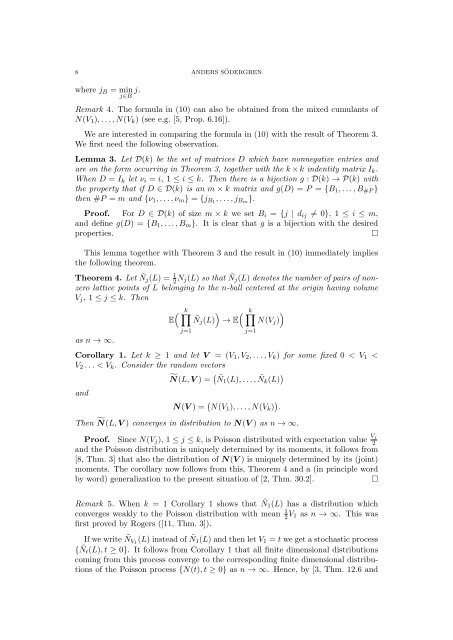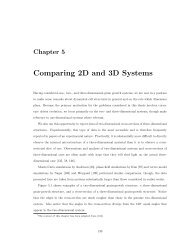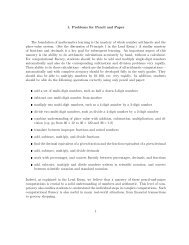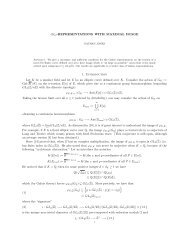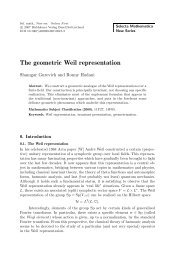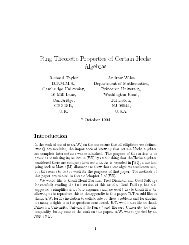8 ANDERS SÖDERGRENwhere j B = minj∈B j.Remark 4. The formula in (10) can also be obtained from the mixed cumulants ofN(V 1 ), . . . , N(V k ) (see e.g. [5, Prop. 6.16]).We are interested in comparing the formula in (10) with the result of Theorem 3.We first need the following observation.Lemma 3. Let D(k) be the set of matrices D which have nonnegative entries andare on the form occurring in Theorem 3, together with the k × k indentity matrix I k .When D = I k let ν i = i, 1 ≤ i ≤ k. Then there is a bijection g : D(k) → P(k) withthe property that if D ∈ D(k) is an m × k matrix and g(D) = P = {B 1 , . . . , B #P }then #P = m and {ν 1 , . . . , ν m } = {j B1 , . . . , j Bm }.Proof. For D ∈ D(k) of size m × k we set B i = {j | d ij ≠ 0}, 1 ≤ i ≤ m,and define g(D) = {B 1 , . . . , B m }. It is clear that g is a bijection with the desiredproperties.□This lemma together with Theorem 3 and the result in (10) immediately impliesthe following theorem.Theorem 4. Let Ñj(L) = 1 2 N j(L) so that Ñj(L) denotes the number of pairs of nonzerolattice points of L belonging to the n-ball centered at the origin having volumeV j , 1 ≤ j ≤ k. Thenas n → ∞.( k∏Ej=1)Ñ j (L) → E( k∏j=1)N(V j )Corollary 1. Let k ≥ 1 and let V = (V 1 , V 2 , . . . , V k ) for some fixed 0 < V 1
ON THE POISSON DISTRIBUTION OF LENGTHS OF LATTICE VECTORS 9Thm. 16.7], the process {Ñt(L), t ≥ 0} converges weakly to the process {N(t), t ≥ 0}as n → ∞. This concludes the proof of Theorem 1.Remark 6. The proof of Theorem 1 can be slightly simplified by considering factorialmoments instead of ordinary moments (cf. [5, Thm. 6.10]). However the present setupwill be useful also when dealing with the moments of the Epstein zeta function,cf. [14].Acknowledgement. The author is grateful to Andreas Strömbergsson for suggestingthe problem and for many helpful discussions and to Svante Janson for valuablecomments.References[1] K. Ball, A lower bound for the optimal density of lattice packings, Internat. Math. Res. Notices1992, no. 10, 217–221.[2] P. Billingsley, Probability and measure, third edition, Wiley Series in Probability and MathematicalStatistics, John Wiley & Sons Inc., New York, 1995.[3] P. Billingsley, Convergence of probability measures, second edition, Wiley Series in Probabilityand Statistics, John Wiley & Sons Inc., New York, 1999.[4] L. K. Hua, Introduction to number theory, Translated from the Chinese by Peter Shiu, Springer-Verlag, 1982.[5] S. Janson, T. ̷Luczak, A. Ruciński, Random graphs, Wiley-Interscience Series in Discrete Mathematicsand Optimization, John Wiley & Sons Inc., New York, 2000.[6] G. A. Kabatyanskii, V. I. Levenshtein, Bounds for packings on a sphere and in space, Problemsof Information Transmission 14 (1978), no. 1, 1–17.[7] J. F. C. Kingman, Poisson processes, Oxford Studies in Probability, vol. 3, The ClarendonPress, Oxford University Press, New York, 1993.[8] L. C. Petersen, On the relation between the multidimensional moment problem and the onedimensionalmoment problem, Math. Scand. 51 (1982), no. 2, 361–366.[9] C. A. Rogers, Mean values over the space of lattices, Acta Math. 94 (1955), 249–287.[10] C. A. Rogers, The moments of the number of points of a lattice in a bounded set, Phil. Trans.R. Soc. Lond. A. 248 (1955), 225–251.[11] C. A. Rogers, The number of lattice points in a set, Proc. London Math. Soc. (3) 6 (1956),305–320.[12] P. Sarnak, Values at integers of binary quadratic forms, Harmonic analysis and number theory(Montreal, 1996, CMS Conf. Proc., 21), Amer. Math. Soc., Providence, RI, 1997, pp. 181–203.[13] W. M. Schmidt, Masstheorie in der Geometrie der Zahlen, Acta Math. 102 (1959), 159–224.[14] A. Södergren, On the value distribution and moments of the Epstein zeta function to the rightof the critical strip, in preparation.[15] J. M. VanderKam, Correlations of eigenvalues on multi-dimensional flat tori, Comm. Math.Phys. 210 (2000), no. 1, 203–223.Department of Mathematics, Uppsala University, Box 480,SE-75106 Uppsala, Swedensodergren@math.uu.se


